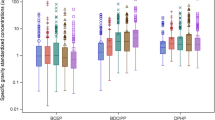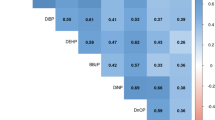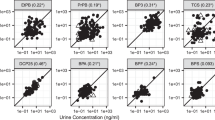Abstract
A few studies have reported concurrent levels of chlorpyrifos (CPF) and diazinon (DZN) and their environmentally occurring metabolites, 3,5,6-trichloro-2-pyridinol (TCP) and 2-isopropyl-6-methyl-4-pyrimidinol (IMP), in food and in environmental media. This information raises questions regarding the reliability of using these same metabolites, TCP and IMP, as urinary biomarkers to quantitatively assess the everyday exposures of children to CPF and DZN, respectively. In this study, we quantified the distributions of CPF, DZN, TCP, and IMP in several environmental and personal media at the homes and day-care centers of 127 Ohio preschool children and identified the important sources and routes of their exposures. The children were exposed to concurrent levels of these four chemicals from several sources and routes at these locations. DZN and IMP were both detected above 50% in the air and dust samples. CPF and TCP were both detected in greater than 50% of the air, dust (solid), food, and hand wipe samples. TCP was detected in 100% of the urine samples. Results from our regression models showed that creatinine levels (<0.001), and dietary (P<0.001) and inhalation (P<0.10) doses of TCP were each significant predictors of urinary TCP, collectively explaining 27% of the urinary TCP variability. This information suggests that measurement of urinary TCP did not reliably allow quantitative estimation of the children's everyday environmental exposures to CPF.
This is a preview of subscription content, access via your institution
Access options
Subscribe to this journal
Receive 6 print issues and online access
$259.00 per year
only $43.17 per issue
Buy this article
- Purchase on Springer Link
- Instant access to full article PDF
Prices may be subject to local taxes which are calculated during checkout

Similar content being viewed by others
References
Adgate J.L., Barr D.B., Clayton A., Eberly L.E., Freeman N.C.G., and Lioy P.J., et al. Measurement of children's exposure to pesticides: analysis of urinary metabolite levels in probability-based sample. Environ Health Perspect 2001: 109 (6): 583–590.
Bakke J.E., and Price C.E. Metabolism of OO-dimethyl-O-(3,5,6-trichloro-2-pyridyl) phosphorothioate in sheep and rats and of 3,5,6-trichloro-2-pyridinol in sheep. J Environ Sci Health 1976: B11 (1): 9–22.
Barr D.B., Wilder L.C., Caudill S.P., Gonzalez A.J., Needham L.L., and Pirkle J.L. Urinary creatinine concentrations in the U.S. Population: Implications for urinary biologic monitoring measurements. Environ Health Perspect 2005: 113 (2): 192–200.
CDC (Centers for Disease Control and Prevention). Third national report on human exposure to environmental chemicals, 2005: http://www.cdc.gov/exposurereport/.
Chuang J.C., Brinkman M., Hart K., Davis D.B., Finegold J., and Gordon S.M. Method refinement and analysis of food data, USEPA. Report to USEPA, Contract 68-D4-0023, WA 4-03. Battelle Memorial Institute, Columbus Ohio, USA, 1999.
Eaton D.L., Daroff R.B., Autrup H., Bridges J., Buffler P., and Costa L.G., et al. Review of the toxicology of chlorpyrifos with emphasis on human exposure and neurodevelopment. Crit Rev Toxicol 2008: 38 (1): 1–125.
Food and Drug Administration (FDA). FDA's total diet study—monitoring U.S. food supply safety. http://www.fda.gov/Food/FoodSafety/FoodContaminantsAdulteration/TotalDietStudy/ucm186140.htm, 2006.
Garfitt S.J., Jones K., Mason H.J., and Cocker M.J. Exposure to the organophosphate diazinon: data from a human volunteer study with oral and dermal doses. Toxicol Lett 2002: 134: 105–113.
Griffin P., Mason H., Heywood K., and Cocker J. Oral and dermal absorption of chlorpyrifos: a human volunteer study. Occup Environ Med 1999: 56: 10–13.
Hines C.J., and Deddens J.A. Determinants of chlorpyrifos exposures and urinary 3,5,6-trichloro-2-pyridinol levels among termiticide applicators. Ann Occup Hyg 2001: 45: 309–321.
Koch H., and Angerer J. Analysis of 3,5,6-trichloro-2-pyridinol in urine samples from the general population using gas chromatography-mass spectrometry after steam distillation and solid-phase extraction. J Chromatogr B 2001: 759: 43–49.
Lu C., Bravo R., Caltabiano L.M., Irish R.M., Weerasekera G., and Barr D.B. The presence of dialkylphosphates in fresh fruit juices: implications for organophosphorus pesticide exposure and risk assessments. J Toxicol Environ Health A 2005: 68 (3): 209–227.
Miller L.A., and Stapleton F.B. Urinary volume in children with urolithiasis. J Urol 1989: 141 (4): 918–920.
Morgan M.K., Sheldon L.S., Croghan C.W., Chuang J.C., Lordo R., and Wilson N.K., et al. A pilot study of children's total exposure to persistent pesticides and other persistent organic pollutants (CTEPP). EPA/600/R-041/193. http://www.epa.gov/heasd/ctepp/ctepp_report.pdf, 2004.
Morgan M.K., Sheldon L.S., Croghan C.W., Jones P.A., Robertson G.L., and Chuang J.C., et al. Exposures of preschool children to chlorpyrifos and its degradation product 3,5,6-trichloro-2-pyridinol in their everyday environments. J Expo Anal Environ Epidemiol 2005: 15: 297–309.
Nolan R.J., Rick D.L., Freshour N.L., and Saunders J.H. Chlorpyrifos: pharmacokinetics in human volunteers. Toxicol Appl Pharmacol 1984: 73: 8–15.
Poet T., Kousba A., Dennison S., and Timchalk C. Physiologically based pharmacokinetic/pharmacodynamic model for the organophosphorus pesticide diazinon. Neurotoxicology 2004: 25 (6): 1013–1030.
Racke K.D. Environmental fate of chlorpyrifos. Rev Environ Contam Toxicol 1993: 131: 1–150.
Raina R., and Sun L. Trace level determination of selected organophosphorus pesticides and their degradation products in environmental air samples by liquid chromatography-positive ion electrospray tandem mass spectrometry. J Environ Sci Health B 2008: 43 (4): 323–332.
Rigas M.L., Okino M.S., and Quackenboss J.J. Use of a pharmacokinetic model to assess chlorpyrifos exposure and dose in children, based on urinary biomarker measurements. Toxicol Sci 2001: 61: 374–381.
Ross J.H., Driver J.H., Cockran R.C., Thongsinthusak T., and Kreiger R.I. Could pesticide toxicology studies be more relevant to occupational risk assessment? Ann Occup Hyg 2001: 45 (1001): S5–S17.
Szabo L., and Fegyverneki S. Maximum and average urine flow rates in normal children—the Miskoln nomograms. Br J Urol 1995: 76 (1): 16–20.
Timchalk C., Busby A., Campbell J.A., Needham L.L., and Barr D.B. Comparative pharmacokinetics of the organophosphorus insecticide chlorpyrifos and its major metabolites diethylphosphate, diethythiophosphate and 3,5,6-trichloro-2-pyridinol in the rat. Toxicology 2007: 237 (1-3): 145–157.
Timchalk C., Poet T.S., Hinman M.N., Busby A.L., and Kousba A.A. Pharmacokinetics and pharmacodynamics interaction for a binary mixture of chlorpyrifos and diazinon in the rat. Toxicol Appl Pharmacol 2005: 205 (1): 31–42.
USEPA. Chlorpyrifos-methyl, 2000: http://www.epa.gov/oppsrrd1/reregistration/chlorpyrifos-methyl/.
USEPA. Chlorpyrifos facts, 2002: http://www.epa.gov/oppsrrd1/REDs/factsheets/chlorpyrifos_fs.htm.
USEPA. Diazinon, 2008: http://www.epa.gov/opp00001/reregistration/diazinon/.
Weerasekera G., Smith K.D., Quiros-Alcala L., Fernandez C., Bradman A., Eskenazi B., Needham L.L., and Barr D.B. A mass spectrometry-based method to measure dialkylphosphate degradation products of organophosphorous insecticides in dust and orange juice. J Environ Monit 2009: 11: 1345–1351.
Wilson N.K., Chuang J.C., Iachan R., Lyu C., Gordon S.M., and Morgan M.K., et al. Design and sampling methodology for a large study of preschool children's aggregate exposures to persistent organic pollutants in their everyday environments. J Expo Anal Environ Epidemiol 2004: 14: 260–274.
Wilson N.K., Chuang J.C., and Lyu C. Levels of persistent organic pollutants in several child day care centers. J Expo Anal Environ Epidemiol 2001: 11: 449–458.
Wilson N.K., Chuang J.C., Lyu C., Menton R., and Morgan M.K. Aggregate exposures of nine preschool children to persistent organic pollutants at daycare and at home. J Expo Anal Environ Epidemiol 2003: 13 (1): 187–202.
Wilson N.K., Chuang J.C., Strauss W., Lyu C., Iroz-Elardo N., and Pivetz T. Pesticide Exposures of Preschool Children Over Time (PEPCOT), National Center for Environmental Research, Washington DC. Final Report, STAR Grant R829363 2008.
Wilson N.K., Strauss W.J., Iroz-Elardo N., and Chuang J.C. Exposures of preschool children to chlorpyrifos, diazinon, pentachlorophenol, and 2,4-diphenoxyacetic acid over 3 years from 2003 to 2005: A longitudinal model. J Expo Sci Environ Epidemiol 2009 (advance online publication, 2 September 2009; doi:10.1038/jes.2009.45).
Zhang X., Driver J.H., Li Y., Ross J.H., and Kreiger R.I. Dialklphosphate (DAPs) in fruits and vegetables may confound biomonitoring in organophosphorus insecticide exposure and risk assessment. J Agric Food Chem 2008: 56: 10638–10645.
Acknowledgements
We thank the participants for participating in this important observational human exposure measurements study. We also thank J. Sobus from the USEPA for his technical guidance in the advanced statistical analyses of these data. In addition, we would also like to thank Battelle staff members, particularly C. Lyu, J. Satola, R. Lordo, and Y. Chou, for their valuable contributions to the success of this study.
Author information
Authors and Affiliations
Corresponding author
Ethics declarations
Competing interests
The authors declare no conflict of interest.
Additional information
Disclaimer
The United States Environmental Protection Agency, through its Office of Research and Development, funded and managed the research described here under Contract #68-D-99-011 to Battelle. It has been subjected to Agency review and approved for publication.
Rights and permissions
About this article
Cite this article
Morgan, M., Sheldon, L., Jones, P. et al. The reliability of using urinary biomarkers to estimate children's exposures to chlorpyrifos and diazinon. J Expo Sci Environ Epidemiol 21, 280–290 (2011). https://doi.org/10.1038/jes.2010.11
Received:
Accepted:
Published:
Issue Date:
DOI: https://doi.org/10.1038/jes.2010.11
Keywords
This article is cited by
-
Prenatal chlorpyrifos leads to autism-like deficits in C57Bl6/J mice
Environmental Health (2017)
-
Reliability of concentrations of organophosphate pesticide metabolites in serial urine specimens from pregnancy in the Generation R Study
Journal of Exposure Science & Environmental Epidemiology (2015)
-
Assessment of chlorpyrifos exposure and absorbed daily doses among infants living in an agricultural area of the Province of Jiangsu, China
International Archives of Occupational and Environmental Health (2014)



